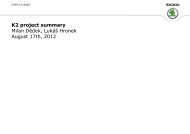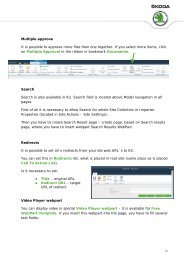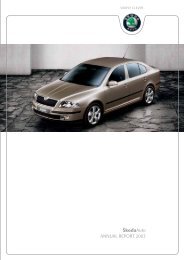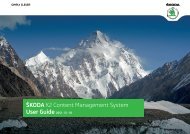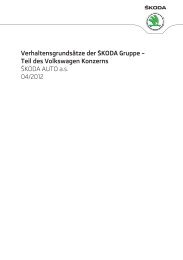Å kodaAuto ANNUAL REPORT 2006 - Skoda Auto
Å kodaAuto ANNUAL REPORT 2006 - Skoda Auto
Å kodaAuto ANNUAL REPORT 2006 - Skoda Auto
Create successful ePaper yourself
Turn your PDF publications into a flip-book with our unique Google optimized e-Paper software.
1.11 Provisions for employee benefits<br />
The following types of long-term employee benefits are included in the provision for employee benefits:<br />
– Bonuses for long-service awards and<br />
– Retirement bonuses.<br />
The entitlement to these benefits is usually conditional on the employee remaining in service for a certain service period, e.g. up to the<br />
retirement age in the case of retirement bonuses or up to the moment of the completion the certain work anniversary of the employee.<br />
The amount of provision corresponds to the present value of the other long-term employee benefits at the balance sheet date using the<br />
projected unit credit method. These obligations are valued annually by independent qualified actuaries. Actuarial gains and losses arising<br />
from changes in actuarial assumptions and calculations are charged or credited to income statement.<br />
The present value of the other long-term employee benefits is determined by discounting the estimated future cash outflows using interest<br />
rates of high-quality corporate bonds to the balance sheet date. If a market of such bonds does not exist, the Company uses the market<br />
price of treasury bonds. The conditions and currency of these corporate or treasury bonds are consistent with the currency and conditions<br />
of the particular other long-term employee benefits.<br />
1.12 Other provisions<br />
In accordance with IAS 37, provisions are recognised where a present obligation exists to third parties as a result of a past event; where<br />
a future outflow of resources is probable; and where a reliable estimate of that outflow can be made. Future outflows are estimated with<br />
respect to particular specific risks. Provisions not resulting in an outflow of resources in the year immediately following are recognised at<br />
their settlement value discounted to the balance sheet date based on the effective interest method. Discounting is based on market<br />
interest rates.<br />
Where there are a number of similar obligations, the likelihood that an outflow will be required in settlement is determined by considering<br />
the class of obligations as a whole. A provision is recognised even if the likelihood of an outflow with respect to any one item included in<br />
the same class of obligations may be small.<br />
1.13 Liabilities<br />
Non-current liabilities are recognized initially at fair value. Subsequently they are recorded at amortized cost in the balance sheet. Any<br />
differences between proceeds (net of transaction costs) and the repayment amount and the redemption value are recognized in the<br />
income statement over maturity period using the effective interest method. Current liabilities are recognized at their repayment or<br />
settlement value.<br />
108








